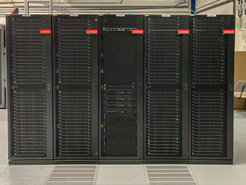Urania: muse of (gravitational-wave) astronomy
New energy-efficient high-performance compute cluster for the Max Planck Institute for Gravitational Physics in Potsdam
The new supercomputer “Urania” has been put into operation by the Max Planck Institute for Gravitational Physics in Potsdam. With 6,048 compute-cores and 22 Terabyte of memory it is just as powerful as its predecessor, but requires only half the electricity to operate. Scientists in the Astrophysical and Cosmological Relativity department are now able to compute gravitational waveforms of coalescing black holes in ever more complex encounters.

The new supercomputer is located at the Max Planck Computing and Data Facility in Garching and replaces the department’s previous cluster, which was called Minerva. Urania will be used for in-depth studies of binary black holes, and the gravitational waves emitted by them. In particular, scientists are interested in pairs of black holes which are either orbiting each other on elliptic orbits, or which are passing each other with their paths being deflected by their mutual gravitational attraction. A second research focus is on binary black-hole simulations, where one of the black holes is much, much smaller than the other one. A major scientific goal is the calculation of the gravitational-wave spectrum emitted by these processes.
Detailed knowledge of the expected signals is essential for searching and analyzing the data of current and future gravitational-wave detectors such as LIGO, Virgo and KAGRA, as well as the Einstein Telescope, Cosmic Explorer and the LISA mission in space. Thus, the newly produced binary black-hole simulations will also be employed by scientists in the department to develop ever more accurate waveform models.
More sensitive detectors require more detailed waveform templates
“We need to include more physically interesting parameters if we are to calculate increasingly accurate waveforms for all possible situations,” says Alessandra Buonanno, director of the Astrophysical and Cosmological Relativity department. “We have already developed a new generation of waveform models for identifying the signals and their sources in the data from current detectors. With Urania, we can account for even more sophisticated binary systems – and at a much lower energy footprint.”
Testing alternative theories of gravity
"The new cluster will also enable computer calculations of black holes in gravitational theories different from Einstein’s theory of General Relativity," explains Harald Pfeiffer, group leader in the Astrophysical and Cosmological Relativity department. "Such predictions will make it possible to quantify which other theory of gravity agrees with the gravitational-wave measurements, and whether such putative alternative theory may even agree better than Einstein's theory."
Urania’s technical specifications
Urania runs on a Linux operating system and has the following features:
- 84 compute nodes, each with 2x 36 core Intel Xeon Platinum 8360Y processors and 256 GB RAM
- Infiniband interconnect
- 1.1PT parallel file system
In total, Urania provides 6,048 compute cores and 22 TB of RAM.
The Astrophysical and Cosmological Relativity department also runs the compute cluster Hypatia of about 8400 CPU cores, dedicated to data analysis as well as to astrophysical, cosmological and fundamental physics studies of gravitational waves.












